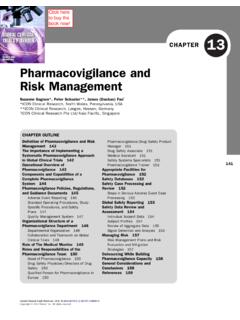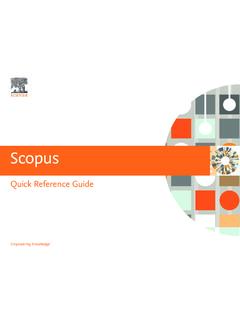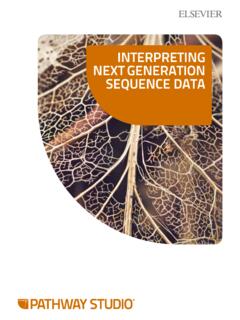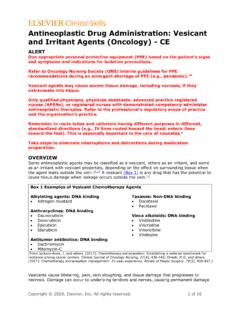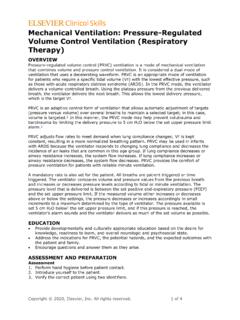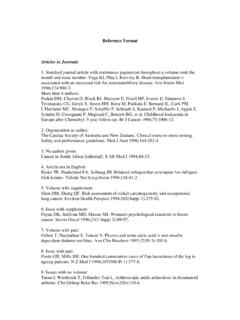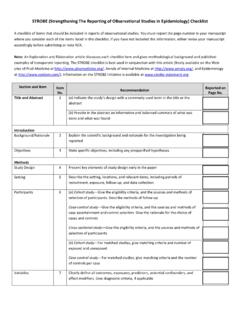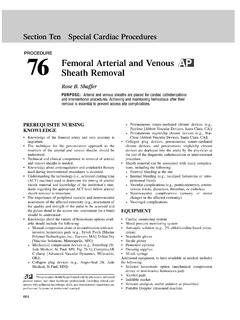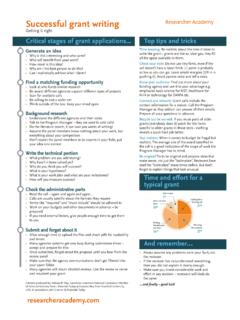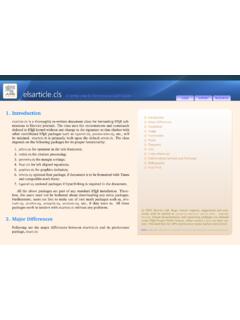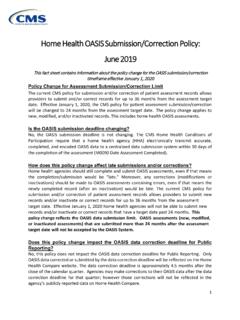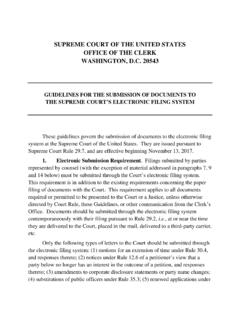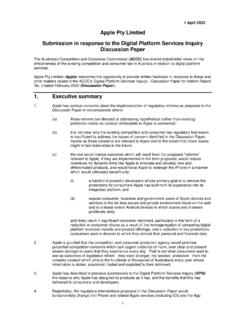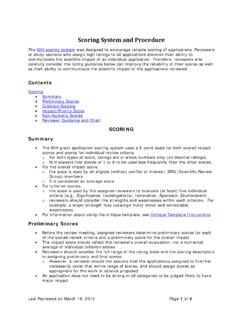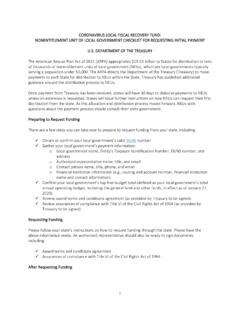Transcription of SUBMISSION CHECKLIST - Elsevier
1 SUBMISSION CHECKLIST To be completed and uploaded with the manuscript at SUBMISSION . Incomplete submissions will not be put into the peer-review process until requirements are met. Incomplete submissions will be removed from the system after 90 days. A more complete description of each item that must be checked, including ethical considerations, is provided under the appropriate heading in the Information for Authors document available at All elements of the manuscript are printed in English and double-spaced with 1-inch margins at top, bottom, and sides. Right margins are unjustified. Separate documents are submitted in the following order: (1) cover letter; (2) title page, including acknowledgments and explanation of any conflicts of interest; (3) main text file (manuscript without author identifiers) including a structured or standard abstract, keywords, list of abbreviations, body of the text, references, suppliers list, figure legends; (4) figures; (5) tables; (6) appropriate completed reporting guideline ( CONSORT, PRISMA, etc.)
2 (7) appendices; (8) supplementary files; (9) author CHECKLIST ; (10) disclosure forms (ICMJE Form for Disclosure of Potential Conflicts of Interest. Cover Letter The cover letter should include essential information, including who the corresponding author will be and a statement signed by the corresponding author that written permission has been obtained from all persons named in the Acknowledgments and patient consent forms have been collected, if needed. Title Page These elements are in the following sequence and are typed double-spaced. Running head of no more than 40 character spaces. Title. Author(s) full name(s) written as First Name then Last Name, and highest academic degree(s). The name(s) of the institution(s), section(s), division(s), and department(s) where the study was performed and the institutional affiliation(s) of the author(s) at the time of the study.)
3 An asterisk after an author s name and a footnote may indicate a change in affiliation. Acknowledgment of any presentation of this material, to whom, when, and where. Acknowledgment of financial support, including grant numbers. Explanation of any conflicts of interest. Name, address, business telephone number, and e-mail address of corresponding author and the author from whom reprints can be obtained. If reprints are not available, this is stated on the title page. Clinical trial registration number, if applicable. Manuscript Body Archives uses a double-blind peer-review process. The blinded SUBMISSION should be submitted in a word document and should begin with a title followed by the abstract and then the text. This document is consecutively line numbered. If this is a randomized controlled trial, provide the CONSORT flow diagram ( ). Statement is included in the body of the manuscript that human experimentation has been approved by the local institutional review board or conforms to Helsinki Declaration, as stated in the section Manuscript Preparation, Methods.
4 Guidelines for the care/use of nonhuman animals or other species, approved by the institution, have been followed as indicated in the Methods. The species is named in the title, abstract, and Methods section. It is recommended that a professional editor or a colleague fluent in English edit the manuscript before SUBMISSION for authors whose first language is not English. The body of the manuscript includes the Introduction (no heading needed), Methods, Results, Discussion, Study Limitations (subheading), and Conclusions headings. Longer articles may need other subsection headings to clarify their content, especially the Results and Discussion sections. Other types of articles such as Commentaries and Special Communications do not require this format. Footnotes other than for references are not allowed in the manuscript body. Abstract For Original Research Articles, Brief Reports, and Review Articles, a structured abstract of 275 words or fewer with Key Words is included before the body of the manuscript and is headed by the title.
5 Note that original research and reviews have different formats for their abstracts. For other manuscripts ( , Commentaries, Editorials and Special Communications), include a conventional, unstructured abstract of no more than 250 words with Key Words before the body of the manuscript and headed by the title. Abbreviations Authors should include a list of abbreviations in their manuscript file following the abstract (just above introduction). Archives uses only standard abbreviations with Davis s and Dorland s as our guides. Abbreviations that are used ONLY in tables, appendices, or figures are not included in the list and should be defined in the relevant table, appendix, or figure note; however, abbreviations that are in the list need not be re-defined in a table footnote or legend. All abbreviations must be defined on first mention in the body of the manuscript.
6 The abbreviations SD (standard deviation) and SE (standard error) require no definition in Archives. References All references have been checked for accuracy and completeness. All references are numbered consecutively in the order they are cited in the text; all listed references have been cited in the text. For any reference cited as "in press," a copy of the article is included. Personal communications and unpublished observations are not used as numbered references but are mentioned in the text with the written approval of the person being quoted. Author must include a copy of the approval. Suppliers are not listed in the reference list or included in the reference numbering (see below). Suppliers Provide a list (after the Reference section) including all manufacturers and other nondrug products used directly in the study. They should be in an alphabetized, superscripted list ( , a, b, ).
7 Provide names for each Supplier. Equipment and/or materials are identified in text, tables, and legends by superscript lower case letters, corresponding to the list of suppliers. Suppliers are listed consecutively in the order they are cited in the text. Figure Legends A list of figure legends should be provided after the reference list and suppliers list, listing each figure in order by number. Legends/captions should not be embedded in the figure files themselves. Figures Each is numbered with an Arabic numeral and cited in numeric sequence in the text. Each figure is provided in a separate document Photographs of recognizable persons require a signed release from the patient or legal guardian authorizing publication. Masking eyes to hide identity is not sufficient. (Author should be able to provide signed release forms when requested.) If a CONSORT diagram is included, it should be assigned a figure number and be included with the list of figure legends.
8 Figures should be submitted in PDF, JPG, EPS, or TIFF format. Tables Each table is provided in a separate document, headed by a title, and numbered in Arabic numerals. Tables are cited in numeric sequence in the text. Tables should be submitted in Word or as a PDF. Please do not import tables into a Word document. Reporting Guidelines To ensure a high and consistent quality of research reporting, original research articles must contain sufficient information to allow readers to understand how a study was designed and conducted. For review articles, systematic or narrative, readers should be informed of the rationale and details behind the literature search strategy. To achieve this goal, Archives, requires that authors upload a completed CHECKLIST for the appropriate reporting guideline during original SUBMISSION . The Archives specifically requests that the following Reporting Guidelines are used when appropriate and strongly encourages authors to use any of the Guidelines listed in the Equator Network ( ): Randomized Controlled Trials CONSORT - Consolidated Standards of Reporting Trials Observational Studies STROBE Strengthening the Reporting of Observational studies in Epidemiology Systematic Review of Controlled Trials PRISMA Preferred Reporting Items for Systematic Reviews and Meta-Analyses Study of Diagnostic accuracy/assessment scale STARD Standards for the Reporting of Diagnostic Accuracy Studies Case Reports CARE for case reports Highlights and Graphical Abstracts (optional) Highlights are a short collection of bullet points that convey the core findings and provide readers with a quick textual overview of the article.
9 Highlights should be submitted as a separate MS Word file in EES by selecting "Highlights" from the drop-down list when uploading files. Include 3 to 5 highlights. There should be a maximum of 85 characters, including spaces, per highlight. Only the core results of the paper should be covered. See For Graphical Abstracts, authors must provide an image that clearly represents the work described in the paper. A key figure from the original paper, summarizing the content can also be submitted as a graphical abstract. Graphical Abstracts should be submitted as a separate file in EES by selecting Graphical Abstracts" from the drop-down list when uploading files. Preferred file types are TIFF, EPS, PDF or MS Office files. See authors/graphical-abstract Similar Publication Upload with the manuscript files a reprint of each article and/or abstract the author and/or coauthors have previously published or is in press, and each manuscript the author and/or coauthors have submitted for possible publication or have in manuscript form dealing with the same patients, animals, laboratory experiment, or data, in part or in full, as those reported in the submitted manuscript.
10 Further explanation of the circumstances should be included in the cover letter, including similarities and differences. Disclosure Forms The ICMJE form only needs to be submitted for the corresponding author at the time of the original SUBMISSION . But ICMJE forms will be needed from all authors should the manuscript move into the revision phase. DEVICE STATEMENT Please check off ONE statement below that pertains to your submitted work. o The manuscript submitted does not contain information about medical device(s). o The device(s) is/are FDA approved for the indicated usage in the United States. o The legal/regulatory status of the device(s) that is/are the subject of this manuscript is/are not applicable in the country where the author(s) resides. o The device(s) that is/are the subject of this manuscript has/have been cleared through the Premarket Notification (510(k)) process/approved through a Premarket Approval application for the indications studied.
